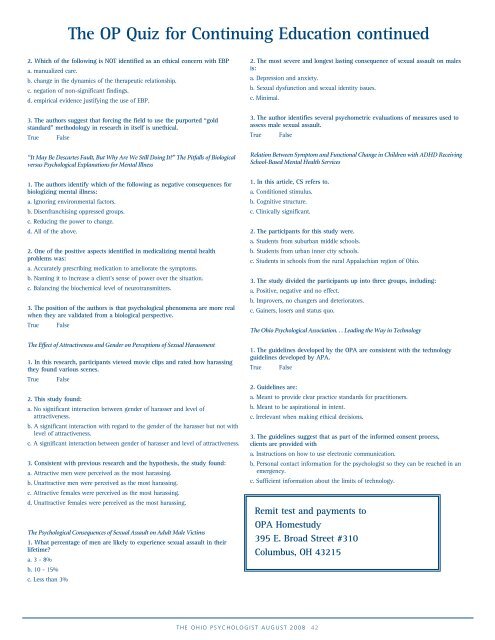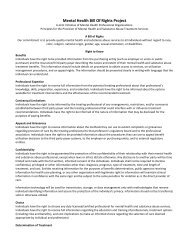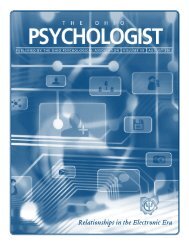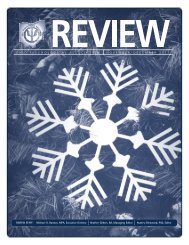2008 Ohio Psychologist - Ohio Psychological Association
2008 Ohio Psychologist - Ohio Psychological Association
2008 Ohio Psychologist - Ohio Psychological Association
Create successful ePaper yourself
Turn your PDF publications into a flip-book with our unique Google optimized e-Paper software.
The OP Quiz for Continuing Education continued<br />
2. Which of the following is NOT identified as an ethical concern with EBP<br />
a. manualized care.<br />
b. change in the dynamics of the therapeutic relationship.<br />
c. negation of non-significant findings.<br />
d. empirical evidence justifying the use of EBP.<br />
3. The authors suggest that forcing the field to use the purported “gold<br />
standard” methodology in research in itself is unethical.<br />
True False<br />
“It May Be Descartes Fault, But Why Are We Still Doing It” The Pitfalls of Biological<br />
versus <strong>Psychological</strong> Explanations for Mental Illness<br />
1. The authors identify which of the following as negative consequences for<br />
biologizing mental illness:<br />
a. Ignoring environmental factors.<br />
b. Disenfranchising oppressed groups.<br />
c. Reducing the power to change.<br />
d. All of the above.<br />
2. One of the positive aspects identified in medicalizing mental health<br />
problems was:<br />
a. Accurately prescribing medication to ameliorate the symptoms.<br />
b. Naming it to increase a client’s sense of power over the situation.<br />
c. Balancing the biochemical level of neurotransmitters.<br />
3. The position of the authors is that psychological phenomena are more real<br />
when they are validated from a biological perspective.<br />
True False<br />
The Effect of Attractiveness and Gender on Perceptions of Sexual Harassment<br />
1. In this research, participants viewed movie clips and rated how harassing<br />
they found various scenes.<br />
True False<br />
2. This study found:<br />
a. No significant interaction between gender of harasser and level of<br />
attractiveness.<br />
b. A significant interaction with regard to the gender of the harasser but not with<br />
level of attractiveness.<br />
c. A significant interaction between gender of harasser and level of attractiveness.<br />
3. Consistent with previous research and the hypothesis, the study found:<br />
a. Attractive men were perceived as the most harassing.<br />
b. Unattractive men were perceived as the most harassing.<br />
c. Attractive females were perceived as the most harassing.<br />
d. Unattractive females were perceived as the most harassing.<br />
The <strong>Psychological</strong> Consequences of Sexual Assault on Adult Male Victims<br />
1. What percentage of men are likely to experience sexual assault in their<br />
lifetime<br />
a. 3 - 8%<br />
b. 10 - 15%<br />
c. Less than 3%<br />
2. The most severe and longest lasting consequence of sexual assault on males<br />
is:<br />
a. Depression and anxiety.<br />
b. Sexual dysfunction and sexual identity issues.<br />
c. Minimal.<br />
3. The author identifies several psychometric evaluations of measures used to<br />
assess male sexual assault.<br />
True False<br />
Relation Between Symptom and Functional Change in Children with ADHD Receiving<br />
School-Based Mental Health Services<br />
1. In this article, CS refers to.<br />
a. Conditioned stimulus.<br />
b. Cognitive structure.<br />
c. Clinically significant.<br />
2. The participants for this study were.<br />
a. Students from suburban middle schools.<br />
b. Students from urban inner city schools.<br />
c. Students in schools from the rural Appalachian region of <strong>Ohio</strong>.<br />
3. The study divided the participants up into three groups, including:<br />
a. Positive, negative and no effect.<br />
b. Improvers, no changers and deteriorators.<br />
c. Gainers, losers and status quo.<br />
The <strong>Ohio</strong> <strong>Psychological</strong> <strong>Association</strong>. . . Leading the Way in Technology<br />
1. The guidelines developed by the OPA are consistent with the technology<br />
guidelines developed by APA.<br />
True False<br />
2. Guidelines are:<br />
a. Meant to provide clear practice standards for practitioners.<br />
b. Meant to be aspirational in intent.<br />
c. Irrelevant when making ethical decisions.<br />
3. The guidelines suggest that as part of the informed consent process,<br />
clients are provided with<br />
a. Instructions on how to use electronic communication.<br />
b. Personal contact information for the psychologist so they can be reached in an<br />
emergency.<br />
c. Sufficient information about the limits of technology.<br />
Remit test and payments to<br />
OPA Homestudy<br />
395 E. Broad Street #310<br />
Columbus, OH 43215<br />
THE OHIO PSYCHOLOGIST AUGUST <strong>2008</strong> 42











